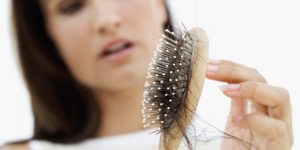By Consultant Dermatologist Dr. Parvathi Padmanabhan
“If clothes make the man, then hair makes the woman”. Today, this should read “ Hair and clothes make the metrosexual man”. Even now in an image-conscious age, when the masculine icon of the youth footballer David Beckham, can voluntarily surrender his trademark dishevelled blond fringe for a shaven head, hair loss is refusing to become fashionable.
Most of us men and women alike are worried about the increasing number of hairs that we find in our hairbrush each day. Why does this happen, and is there anything you can do to stop it?
First, let us understand that some shedding of hair is perfectly normal. Hair is formed in minute pockets in skin, called follicles. An upgrowth at the base of the follicle called the papilla, actually produces hair, when a special group of cells turn amino acids into keratin, a type of protein of which hair is made.
The rate of production of these protein “building blocks” determines the hair growth. Hairs grow from follicles designed to grow a single hair that follows this repetitive cycle.
- Lengthy growth period -Anagen Stage: This phase usually lasts between two and seven years with an average growth rate 1.2 cm per month.
- Short transition period- Catagen Stage: This period of transition lasts for roughly two to four weeks. During this phase the hair shaft becomes detached and moves upwards within the follicle.
- Resting period – Telogen Stage: This phase lasts about three months allowing the hair to detach itself prior to falling out.
At this point, a new hair begins to grow thus repeating the normal cycle of hair growth. Unfortunately, a number of factors can interfere with the natural hair growth process leading to forms of hair thinning or premature baldness.
“A hair in the head is worth two in the brush” – Oliver Herford
On average, each person has 1 million hair follicles, or sacs from which hair may grow, on the scalp. Of this number, only 100,000 to 150,000 have hair growing from them. At any one time 80% to 90% of these follicles are growing hair; the remainder are “resting.” With age, more follicles begin to rest.
Normally, 100 to 150 hairs fall out each day; this number increases each fall and decreases each spring. Occasionally, more hairs fall out than normal–sometimes in clumps–leaving areas of thin hair or baldness. This condition is called alopecia.
The common causes of hair fall:

There are many possible causes of hair loss, however most hair loss is normal, and part of each person’s genetic program.
1. Hereditary:
Hereditary thinning or balding is the most common cause of hair loss. The tendency can be inherited from either the mother’s or father’s side of the family. The condition is called androgenetic alopecia. When it occurs in some men, they begin to lose hair at the top or front of the head starting between ages 20 and 40. This type of alopecia eventually also affects at least one in four women, who lose some or a lot of hair all over their head.
2. Alopecia areata:
In this type of hair loss, hair usually falls out, resulting in totally smooth, round patches about the size of a coin or larger. It can, rarely, result in complete loss of scalp and body hair. In most cases, the hair regrows by itself. Dermatologists can treat many people with this condition.
3. Childbirth:
When a woman is pregnant, more of her hair will be growing. However, after a woman delivers her baby, many hairs enter the resting phase of the hair cycle. Within two to three months, some women will notice large amounts of hair coming out in their brushes and combs. This can last one to six months, but resolves completely in most cases.
4. High fever and severe infection:
Illnesses may cause hairs to enter the resting phase. Four weeks to three months after a high fever, severe illness or infection, a person may be shocked to see a lot of hair falling out. This shedding usually corrects itself.
5. Thyroid disease:
Both an over-active thyroid and an under-active thyroid can cause hair loss and diagnosed with laboratory tests and can be reversed with proper treatment.
6. Inadequate protein in diet:

Some people who go on crash diets that are low in protein, or have abnormal eating habits, may develop protein malnutrition. The body will save protein by shifting growing hair into the resting phase. Massive hair shedding can occur two to three months later. This condition can be reversed and prevented by eating the proper amount of protein and, when dieting, maintaining adequate protein intake.
7. Medications:
Some prescription drugs may cause temporary hair shedding. Examples include some of the medicines used for the following: gout, arthritis, depression, heart problems, high blood pressure, or blood thinner and high doses of vitamin A..
8. Cancer treatment:
Some cancer treatments will cause hair cells to stop dividing. Patients can lose up to 90 percent of their scalp hair. The hair will re-grow after treatment ends.
9. Birth control pills:
Women who lose hair while taking birth control pills usually have an inherited tendency for hair thinning. If hair thinning occurs, a woman can consult her gynecologist about switching to another birth control pill. When a woman stops using oral contraceptives, she may notice that her hair begins shedding two or three months later. This may continue for six months when it usually stops. This is similar to hair loss after the birth of a child.
10. Low serum iron:
Iron deficiency occasionally produces hair loss. Some people do not have enough iron in their diets or may not fully absorb iron. Women who have heavy menstrual periods may develop iron deficiency. Low iron can be detected by laboratory tests and can be corrected by taking iron pills. In rare cases, a lack of zinc may be to blame.
11. Major surgery/chronic illness:
Anyone who has a major surgical operation may notice increased hair shedding within one to three months afterwards. The condition reverses itself within a few months but people who have a severe chronic illness may shed hair indefinitely.
12. Fungus infection of the scalp:
Ringworm (which has nothing to do with worms) begins as small patches of scaling that can spread and result in broken hair, redness, swelling, and even oozing. This contagious disease is most common in children and oral medication will cure it.
13. Hair-pulling (Trichotillomania):
Children and sometimes adults will twist or pull their hair, brows or lashes until they come out. In children especially, this is often just a bad habit that gets better when the harmful effects of that habit are explained. Sometimes hair pulling can be a coping response to unpleasant stresses and occasionally is a sign of a serious problem needing the help of mental health professional.
14. Improper hair cosmetic use or improper hair care:
Use of chemical treatments on hair, including dyes, tints, bleaches, straighteners and permanent waves rarely damage hair if they are done correctly. However, the hair can become weak and break if any of these chemicals are used too often.
Hairstyles that pull on the hair, like ponytails and braids, should not be pulled tightly and should be alternated with looser hairstyles. Constant pull causes some hair loss, especially along the sides of the scalp. Shampooing, combing and brushing too often can also damage hair, causing it to break.
Using a cream rinse or conditioner after shampooing will make it easier to comb and more manageable. When hair is wet, it is more fragile, so vigorous rubbing with a towel, and rough combing and brushing should be avoided. Use wide toothed combs and brushes with smooth tips.
Dermatologists will evaluate a patient’s hair problem by asking questions about diet, medications including vitamins and health food taken in the last six months, family history of hair loss, recent illness and hair care habits.
Hormonal effects may be evaluated in women by asking about menstrual cycles, pregnancies and menopause. After examining the scalp and hair, the dermatologist may check a few hairs under the microscope. Sometimes blood tests or a scalp biopsy may be required for an accurate diagnosis. It is important to find the cause and whether or not the problem will respond to medical treatment.
Many cases of hair loss get better on their own over time. Others may respond slowly to treatment. However, any hair that grows back may be thinner than the hair you had originally. It is a good idea to doubt advertising claims about so-called cures using vitamins, herbs, or nutritional supplements; none of these treatments have been proven to work for hair loss.
For hair loss caused by illness such as fever, radiation therapy, or medication use, no treatment is necessary. The hair will usually grow back when illness has ended or therapy has stopped. A wig, hat, or other covering may be desired until the hair grows back.
For hair loss due to heredity, there is no cure, although medical treatments have recently become available that may help some people. One treatment involves applying a lotion, minoxidil, to the scalp twice a day. Another treatment for men is a daily pill containing finasteride, a drug that blocks the formation of the active male hormone in the hair follicle but drugs for hair fall should only be taken after consultation with the doctor since they might not be suitable under certain conditions and some of them may also have serious side effects.
Role of diet in hair care:
Diet plays a very important part. A diet which contains liberal quantities of seeds, nuts and grains, vegetables and fruits, provides adequate amounts of all essential nutrients. These foods should be supplemented with certain special foods such as milk, vegetable oils, honey, wheat germ, yeast and liver.
Too much of stress and pollution may also be a cause, so attention must be paid to these as well.
Hair transplantation, which is a permanent form of hair replacement is the last resort. Anyone who has suffered permanent hair loss may be a candidate for hair transplantation. The procedure of hair transplantation involves moving some hair from hair-bearing portions (donor sites) of the head to bald or thinning portions (recipient sites) or removing bald skin.
Because the procedures involve surgery as well as time and money, they should not be undertaken lightly. Punch graft hair transfer done by a physician is a surgical approach to transferring hair from one part of the head to another. It is somewhat painful and expensive, but usually permanent.
People have always been surprisingly gullible where their hair is concerned. So, a scientific and evidence-based approach by a knowledgeable health professional is your best bet in this era of quackery to preserve your “ crown.
Hairstyles that pull on the hair, like ponytails and braids, should not be pulled tightly and should be alternated with looser hairstyles. Constant pull causes some hair loss, especially along the sides of the scalp
